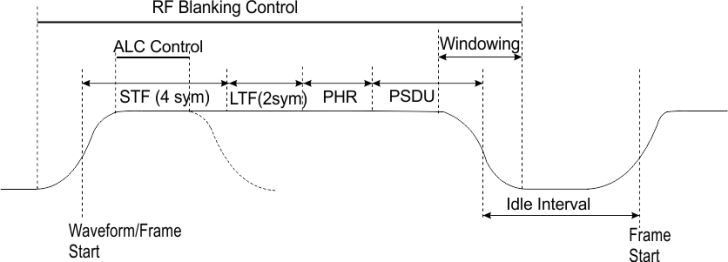
The multi-rate and multi-regional orthogonal frequency division multiplexing (MR-OFDM) provides higher data rates at higher spectral efficiency.
MR-OFDM supports data rates ranging from 50 kbps to 800 kbps. The subcarrier spacing is constant.
There are 4 options for OFDM signals with different bandwidths and DFT sizes and various modulation (BPSK, QPSK and 16QAM).
A MR-OFDM signal is generated on a packet/frame basis. A packet shall include STF (Short Training Field), LTF (Long Training Field), PHR and PSDU parts as defined in the standard and possibly the windowing and idle interval as configured by user. The figure below illustrates the structure of an OFDM packet. A waveform can include one or more packets/frames, depending on user's setting. When idle interval is set to zero, continuous signal (non-burst) will be generated without any idle interval.

The table below shows the format of the MR-OFDM PPDU.
| Number of OFDM Symbols | |||||||||
| Variable | Variable | 6 bits | Variable | ||||||
| SHR | PHR | PHY Payload |
Tail |
PAD |
|||||
| STF | LTF | Rate | Frame Length | Scrambler | HCS | Tail | PSDU | ||
There are 4 OFDM options, each with a different number of active tones. All devices supporting a particular option (1, 2, 3, or 4) shall support all BPSK and QPSK modulation and coding scheme (MCS) levels for that option. All 16 quadrature amplitude modulation (QAM) MCS levels are optional.
The various data rates are shown in Table 148. The nominal bandwidth is calculated by multiplying {the number of active tones + 1 for the DC tone} by {the subcarrier spacing}.